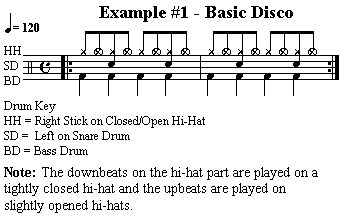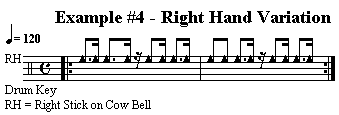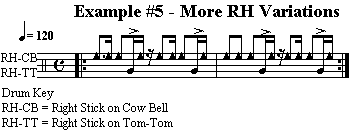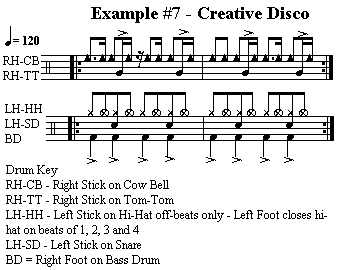Disco Sounds Good, With A Little Creativity
If basic disco beats put you to sleep, try some variations to keep things jumpin'
Back in the mid '70s when the disco style of music first came on the scene, many drummers hated it. The main reason? Disco was just too simple to play. Playing a constant heavy four on the bass drum, two and four on the snare, and off-beats on the hi-hat got downright boring! (See Example #1.)

I was probably one of the few drummers who actually enjoyed playing disco only because I chose to improvise a little and add my own variations to the basic beat.
This week, I'll show you some examples of what I did in the hopes that it will give you some inspiration to modify drum patterns that bore you.
Make It Sound Full
Don't get me wrong, I don't like to overplay but I do like to sound "full" behind a drum set.
Although I liked the overall feel behind the basic disco pattern, it wasn't quite rhythmically
"full" enough for my taste. So here's what I did to spice it up:
1) Take a look at Example #1. Because there isn't much going on between the left stick snare and the right stick hi-hat parts, I decided to play both parts (including a slight modification) with my left stick only. The modification is to the original HH part in Example #1. Because the right stick normally strikes the hi-hat on the beats of 1, 2, 3, and 4 at the same time the left foot closes it anyway, I played only the off-beats on the hi-hat with the left stick. This made it easy to play the left stick on the beats of two and four on the snare.
This totally freed up my right hand. Try it yourself. For now, keep the bass drum part on steady four to maintain the "heartbeat" of disco, as it shows in Example #1.
2) Next, I experimented with my right stick. I tried mirroring the bass drum part by playing my right stick on straight four on a cowbell. (See Example #2.)

I liked it. It almost sounded like the band had a drummer and a percussionist on board. Not bad, but not quite enough. I then tried some variations to the right hand part and liked it even better. (See Example #3.)

3) Eventually, I got a little further out and played the pattern shown in Example #4.

I loved it. This really sounded like the band had a drummer and a percussionist and, although it didn't fit every disco song, it did fit a lot of them really well.
4) Not having quite enough to do with my right hand yet, I decided to throw in the off-beat "Rock The Boat" type tom-tom part shown in Example #5.

When I added the above Right Stick variation to the rest of the basic disco pattern, it was no longer boring!
Click the play button below to hear a MIDI example:
(If a MIDI player doesn't appear above, you can download one here, for free.)
5) I eventually began to play around with the bass drum part, like in Example #6 (below), and found that it blended perfectly with what I was playing in Example #5. Try it.

Here's an example of the whole thing put together for you, using basic 4 on the BD:

A Little Creativity is All it Takes
Although I chose to use disco in this example, feel free to modify any beat you don't like. As long as you
maintain the predominant rhythmic elements, a little embellishment won't hurt. On the contrary, it often
helps.
Who knows? In the process, you may even create a whole new dance craze! Wait a minute. Is that how they came up with the Macarena? Oh, no... Back to the drawing board!
Stay Loose.
